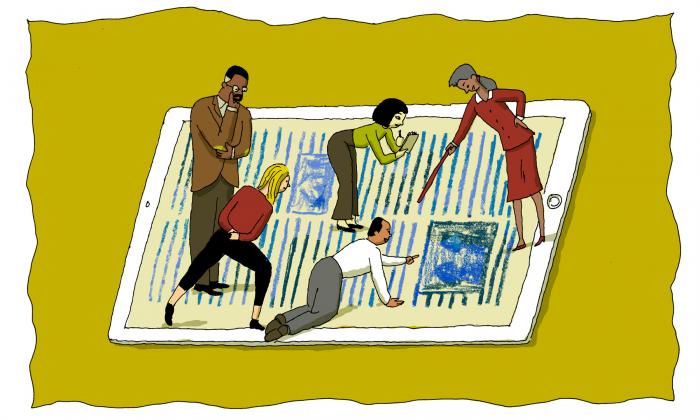Preparing to Teach Digital Literacy
Learners will:
- Understand the seven skills of the Learning for Justice Digital Literacy Framework
- Evaluate their own digital media diets
- Understand common terms related to digital literacy
- Identify ways to integrate digital literacy into their teaching
- Why is digital literacy important?
- What can I do to become more digitally literate?
- What can I do to incorporate digital literacy skills into my teaching?

Overview
The internet is an amazing tool for teaching and learning, but one that works differently from other media. In a digital world, we’re bombarded by information arriving at warp speed. All of us—our students and ourselves—need to know how to quickly sort, evaluate and make decisions about the incoming words, images and memes we encounter, as well as how to create online content effectively and efficiently.
This module offers a series of activities designed to help educators brush up their digital literacy knowledge. It also introduces the Learning for Justice Digital Literacy Framework: seven key areas in which students need support developing digital and civic literacy skills.
Materials
- Digital Literacy Framework
- How Does “Fake” News Become News?
- Digital Literacy Vocabulary Quiz and Speaking of Digital Literacy… answer sheet
- Five Steps to a Balanced Media Diet activity and graphic organizer
- Teaching Digital Literacy webinar
Vocabulary
Cornell University describes digital literacy as the ability to find, evaluate, utilize, share and create content using information technologies and the internet. The Learning for Justice definition of digital literacy is the ability to participate safely, critically, meaningfully and justly in the production and consumption of content online. To see a full list of terms related to the topic of digital literacy, see the handout Speaking of Digital Literacy…
Procedure
Opening Activity
Reflect on these questions and discuss as a group:
- Why is digital literacy important?
- What comes to mind when you think of digital literacy?
- Does digital media inspire or worry you? Why?
Webinar Activity
1. Take the Digital Literacy Vocabulary Quiz individually, or explore it as a group. If in a group, pick several words from the quiz that seem appropriate to your instructional context and a few that you don’t know.
- Write each word on a large piece of paper by itself and display the pieces of paper around the room.
- Break into small groups and rotate to each word.
- Ask each group to write down their best guess at the definition for each word.
- After all small groups have visited each word and written their definitions, share out as a whole group.
2. As a group, watch and discuss the webinar Teaching Digital Literacy. Reflect on the following questions:
- What terms or definitions did you learn while watching the webinar that you can apply to your work with students? To your own media consumption?
- Discuss your reaction or thoughts about the Gorman & Gorman quote: “The issue is not merely providing an explanation that makes people understand but rather an explanation that makes them feel in control.”
- What did you find most helpful in the webinar in terms of deepening your understanding of how to improve your own digital literacy?
3. Close the activity by distributing and reviewing the full definitions on the Speaking of Digital Literacy… handout.
“Fake” News Activity
Watch the video "How Does 'Fake' News Become News?" Discuss observations as a group. Individually, reflect on or write down the answers to these questions:
- Do I live in an echo chamber? What perspectives are recycled in that chamber?
- Where do I get my news?
- Who or what do I trust? Who or what don’t I trust?
- How often do I use social media?
- Do I create or share a lot of digital content?
Share out in small groups, and then discuss how your reflections relate to your students and what you do in the classroom.
Media Diet Activity
1. For homework, review the handout Five Steps to a Balanced Media Diet and complete it for next week.
2. Once everyone comes back together after a week apart, share your thoughts and reflections on the Five Steps to a Balanced Media Diet sheet. Discuss:
- What changes will I make to my media diet based on this exercise?
- How can I leverage this material with students?
Planning Activity
Divide into groups based on the grade levels you teach. Review the appropriate lessons in the Digital Literacy Framework, and plan how you will use the materials with students.